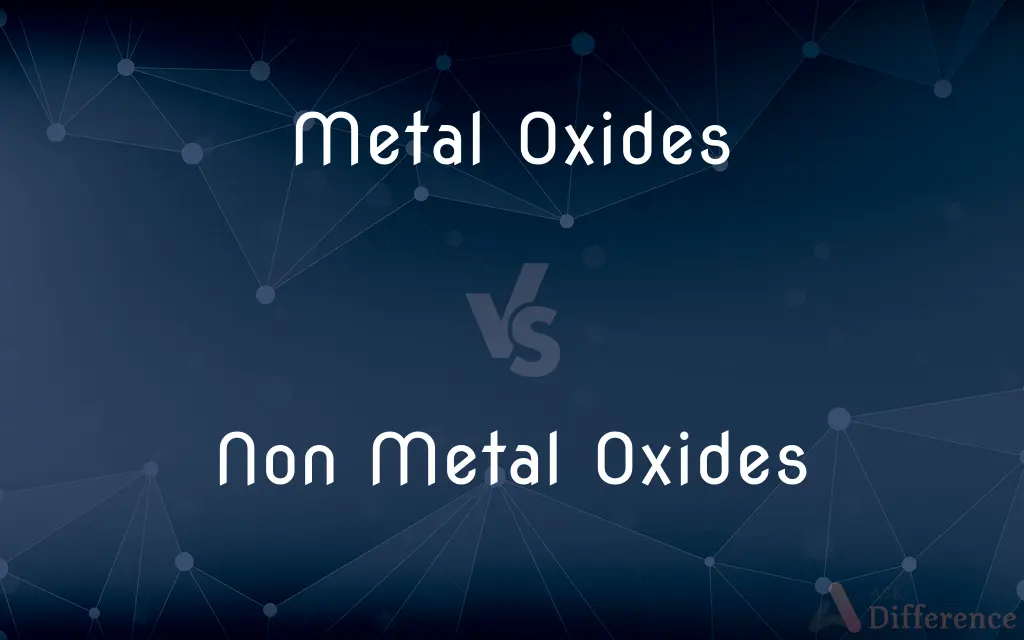Metal Oxides vs. Non Metal Oxides — What's the Difference?
By Tayyaba Rehman — Published on December 17, 2023
Metal Oxides are compounds formed by metals combining with oxygen; Non Metal Oxides form when non-metals bond with oxygen, often yielding acidic solutions.

Difference Between Metal Oxides and Non Metal Oxides
Table of Contents
ADVERTISEMENT
Key Differences
Metal Oxides arise when metals undergo a reaction with oxygen, typically forming basic compounds. These compounds can often react with water to produce bases. Non Metal Oxides, conversely, result from non-metals combining with oxygen, usually leading to acidic or neutral compounds. When Non Metal Oxides interact with water, they often form acidic solutions.
Both Metal Oxides and Non Metal Oxides play crucial roles in various chemical processes. While Metal Oxides are prominently found in earth's crust and are vital in metallurgy, Non Metal Oxides are essential for processes like combustion and respiration. For instance, carbon dioxide, a Non Metal Oxide, is a product of combustion.
In terms of reactivity, Metal Oxides often react with acids to produce salt and water, showcasing their basic nature. Non Metal Oxides, in stark contrast, typically react with bases to produce salt and water, revealing their acidic characteristics. It's interesting to note that while many Metal Oxides are solid at room temperature, some Non Metal Oxides can be gaseous, like carbon dioxide.
Lastly, understanding the distinction between Metal Oxides and Non Metal Oxides is pivotal in areas like environmental science. For example, certain Non Metal Oxides contribute to phenomena like acid rain, whereas Metal Oxides can be pivotal in soil chemistry and fertility.
Comparison Chart
Origin
Formed by metals reacting with oxygen.
Result from non-metals combining with oxygen.
ADVERTISEMENT
Nature
Typically basic.
Usually acidic or neutral.
Reactivity with water
Often produce bases.
Often form acidic solutions.
Physical state
Primarily solids at room temperature.
Can be solids, liquids, or gases.
Reaction with other substances
React with acids to yield salt and water.
React with bases to produce salt and water.
Compare with Definitions
Metal Oxides
Compounds resulting from metals bonding with oxygen.
Aluminum reacts with oxygen to form the Metal Oxide, aluminum oxide.
Non Metal Oxides
Key in processes like combustion and respiration.
During respiration, carbon dioxide, a Non Metal Oxide, is exhaled.
Metal Oxides
Important in metallurgical processes.
In steel manufacturing, various Metal Oxides are reduced to extract their metals.
Non Metal Oxides
Some contribute to environmental issues.
Certain Non Metal Oxides like sulfur dioxide contribute to acid rain.
Metal Oxides
React with acids to produce salt and water.
The Metal Oxide, magnesium oxide, reacts with hydrochloric acid to produce magnesium chloride and water.
Non Metal Oxides
Typically yield acidic or neutral solutions.
Sulfur dioxide, a Non Metal Oxide, forms an acidic solution in water.
Metal Oxides
Typically basic in nature.
Calcium oxide, a Metal Oxide, produces a basic solution when mixed with water.
Non Metal Oxides
React with bases to form salt and water.
Carbon dioxide, a Non Metal Oxide, reacts with calcium hydroxide to produce calcium carbonate and water.
Metal Oxides
Commonly found in the earth's crust.
Bauxite, a primary ore of aluminum, contains the Metal Oxide, aluminum oxide.
Non Metal Oxides
Compounds formed when non-metals combine with oxygen.
Carbon burns in oxygen to produce the Non Metal Oxide, carbon dioxide.
Common Curiosities
Are all Non Metal Oxides gases?
No, while some Non Metal Oxides are gaseous (e.g., CO₂), others can be solid or liquid.
How do Non Metal Oxides differ from Metal Oxides?
Non Metal Oxides are formed when non-metals bond with oxygen, usually resulting in acidic or neutral compounds.
What are Metal Oxides?
Metal Oxides are compounds formed when metals react with oxygen, typically yielding basic properties.
Can Metal Oxides be acidic?
While most Metal Oxides are basic, some, especially those of transition metals, can exhibit acidic properties.
Why are Non Metal Oxides crucial in environmental science?
Some Non Metal Oxides, like sulfur dioxide, play roles in environmental concerns like acid rain.
Are Non Metal Oxides always acidic?
While many are acidic, some Non Metal Oxides can be neutral or even basic.
Can Metal Oxides be reduced?
Yes, many Metal Oxides can be reduced to their respective metals using reducing agents.
How do Metal Oxides react with water?
Many Metal Oxides, when mixed with water, produce basic solutions.
Are Metal Oxides common in the earth's crust?
Yes, many Metal Oxides are abundant in the earth's crust and are mined as ores.
How do Non Metal Oxides interact with water?
Non Metal Oxides often form acidic solutions when dissolved in water.
Can Metal Oxides conduct electricity?
Some Metal Oxides, especially when molten or dissolved in water, can conduct electricity.
Are Non Metal Oxides soluble in water?
Some Non Metal Oxides are soluble, forming acidic solutions, while others are not.
How are Metal Oxides utilized in industry?
Metal Oxides are vital in metallurgy, electronics, and catalysis, among other areas.
What role do Non Metal Oxides play in human health?
Certain Non Metal Oxides, like carbon dioxide, are involved in physiological processes, but in excess, they can be harmful.
Is it possible for Metal Oxides to react with bases?
While less common than reactions with acids, some Metal Oxides can react with bases, especially amphoteric oxides.
Share Your Discovery

Previous Comparison
Trade Paperback vs. Mass Market Paperback
Next Comparison
LCD TV vs. Plasma TVAuthor Spotlight
Written by
Tayyaba RehmanTayyaba Rehman is a distinguished writer, currently serving as a primary contributor to askdifference.com. As a researcher in semantics and etymology, Tayyaba's passion for the complexity of languages and their distinctions has found a perfect home on the platform. Tayyaba delves into the intricacies of language, distinguishing between commonly confused words and phrases, thereby providing clarity for readers worldwide.
















































